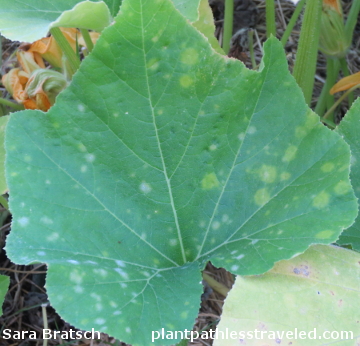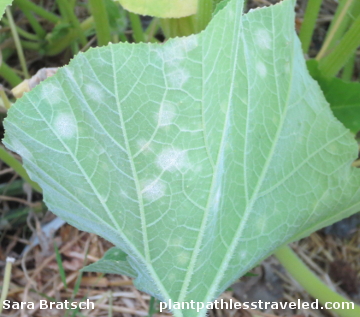Powdery Mildew
Powdery mildew is a common fungal pathogen on many plants. The powdery mildew family has many members, with each species attacking a specific plant or group of plants. A variety of powdery mildew on your lilac is not going to infect your squash plants. Powdery mildew can be found on various vegetables including: bean, beet, carrot, cucumber, eggplant, lettuce, melons, peas, peppers, pumpkins, squash, tomato; various trees and shrubs.
A powdery mildew infection can first be noted with the appearance of yellow spots on leaves. The photo below shows a zucchini leaf with yellow spots where the powdery mildew fungus has first infected. If the leaf is turned over, you will notice some white fuzz which is the fungal mycelia. As the infection spreads the yellow spots will turn white on the top also. The white color comes from the mycelia (filaments) the powdery mildew fungus uses to absorb nutrients and reproduce.


Powdery mildew grows best in warm, humid conditions and is a common pathogen seen in the fruit and vegetable garden. Although plants infected with powdery mildew look very sick, most infections do not result in major damage to the plant host. Heavily colonized leaves of annual vegetables (with >75% leaf covered with powdery mildew) can be pruned. As with most plant pathogens preventative maintenance and planning will help combat it as powdery mildew is an opportunist that is impossible to eradicate in a home garden.

Many trees, shrubs, and vegetables have powdery mildew resistant varieties that can be planted. Proper spacing, pruning, and trellising of plants to allow for good airflow among the leaves will help to limit the development of powdery mildew. Fungicides can be used to protect highly susceptible, valuable plants but must be applied before disease symptoms appear.
All photos were taken by Sara Bratsch. For non commercial use only.
Please contact regarding all other uses.
Cite this article:
Bratsch, Sara. "Powdery Mildew". 18 August 2014. http://plantpathlesstraveled.com/powdery-mildew/